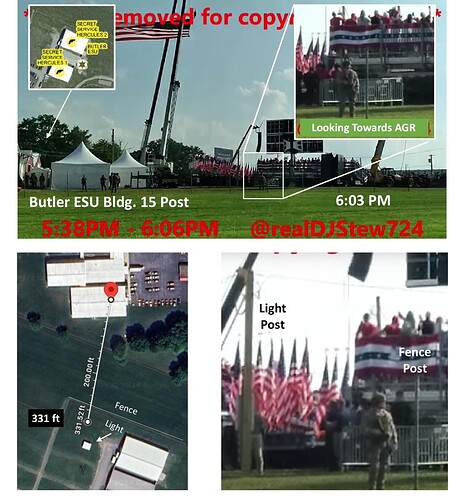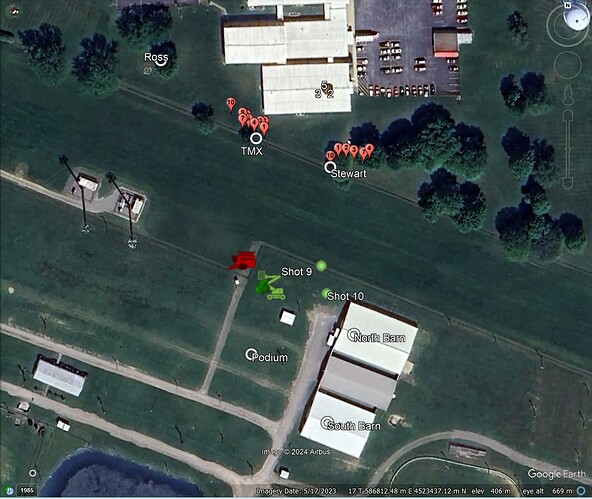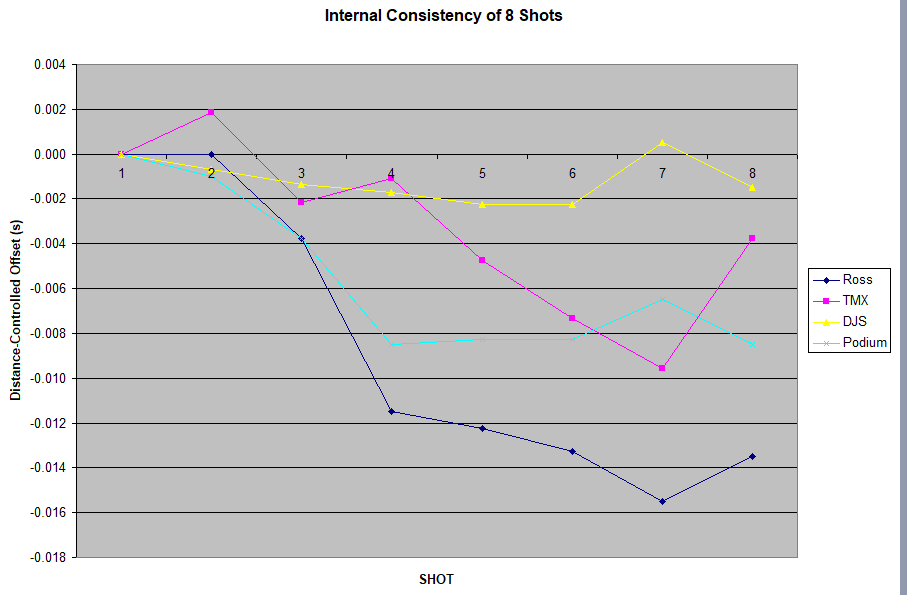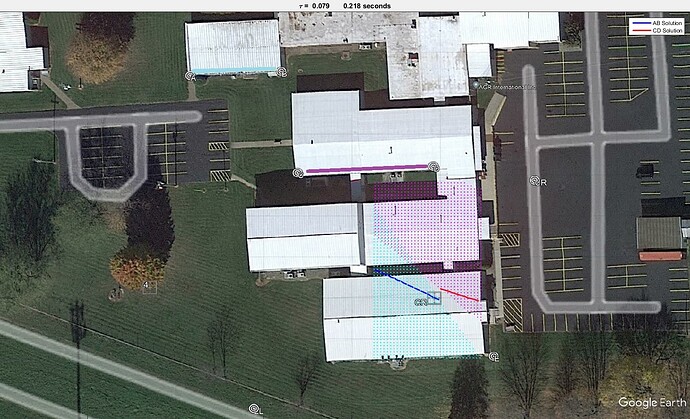How does your Shot 9 calculations align with this ESU member? Granted, he could have moved some from his last filmed location 8 minutes before the shooting, but he seemed pretty stationary up to that point.
Interesting theory and may explain Cheetos “1 in a million” shots she discussed (although she lied about so much and was otherwise totally incompetent, so we have to take what she said cautiously). That officer looks to have probably (based on most tactically sound) some form of the same rifle Crooks had (AR15/M4 type, in 5.56mm), with a unmagnified or low magnification optic.
From a lower elevation position, he’d probably only see the top half of Crooks head or otherwise very little of him, if he was making any efforts to stay low profile. That would have been a very hard shot under those circumstances and stress, perhaps from an unsupported position too.
From his death position, he was still in the offensive position pointing toward the stage, holding rifle, versus defensive (trying to flee, discarded rifle), etc.
Crooks injuries, as we might best-guess, a hole in the top portion of his head, with hydro-static deformation injures to his orbital eye socket and other bulging injuries such as the back of his neck, looks like a busted bone or tooth dangling in the front of his mouth, massive blood loss, but overall intact head are seemingly consistent with a smaller caliber rifle, such as a 5.56mm. Although bullets do behave oddly, I would expect a larger caliber in .308, 300winmag, or .338 would have varying degrees of severed his head from his body and the scene would have been far more gore.
It makes sense that the ESU member I pointed out likely moved closer to the fence and towards a better vantage point, but there was a second ESU member starting to move from the barn area in that direction, but turned back around some at 6:03. Thanks for the updated graphic!
Here is a suggestion for you as another non-moving sound source for your analysis. Just passing it on.
https://m.youtube.com/watch?v=Y0JAQut3usM I’m this video by judicial watch of the body camera footage at the beginning when the cop drives up to building 6 notice someone closes the door and it’s two minutes before the shooting, also at the 11:58 mark you can see officers bringing a all silver ladder that they used in the causeway the photo from the media early on showed a orange or red sided ladder in that spot something is fishy about that. As well as when the police officers are on top they walk in the lane next to shooter and nothing is in the lanes besides the book bag shortly after you can see an officer pull out some yellow bag and put it next to a brown bag and white object that were not in the lanes next to shooter. Also you can see the cell phone which wasn’t there when they climbed up. Someone also left a water bottle where the first officer attempted to climb up you don’t see it when he attempted to climb up but it’s there when they are getting up the second time. I was able to see the unlburred version and nowhere does it show those items in question.
To be fair, immediately after reaching the roof, they are going to:
Remove the rifle from his reach.
Cuff him.
Check his pockets and bags for i.d., phone, keys to a vehicle, possible explosives, and accomplices.
It just makes sense to do that and to do so with urgency.
Greg,
Thank you much for this considerable effort. While you work a TDOA solution, I took the liberty of addressing a simpler, immediate question using your dataset. I simply plotted the apparent differential arrival times of the first 8 shots, offset by the distances calculated between the shooter and each of the 4 sources. This places an upper bound on how far the shooter(s) of 1-3 and 4-8 could have been separated. As the Ross ↔ DJS axis is orthogonal to the TMX ↔ Podium axis, there is nowhere for shooter motion between shots 3 and 4 to hide. The answer is on the order of 8 milliseconds sound travel, or 10 feet. This is an improvement on my own efforts to eyeball the reports and work with them.
I will soon post an analysis showing that this tight radius in not inconsistent with the change in source 4 direct path → echo delays between shots 3 and 4.
Greg_n
With all due respect - I do not agree (do not understand/know the specifics of your audio analysis strategy).
If you take Source 4 (“Ross get over here”) audio track plot and insert a TTOS (true time-of-shot) reference for Shot 4 (assumed to be Crooks’s death position) - then overlay & sync relative Shot timing (using sonic-cracks from Trump’s mic) you will see the following:
(1) up-field signal shifts (to the left)(for the Source 4 audio track signals) for Shots 1-3 -relative to Shot 4 (means that Shots 1-3 are closer to Source 4).
(2) observed up-field signal shifts for Shots 1-3 are all different - and therefore suggests that there are THREE (3) SHOOTERS for Shots 1-3.
(3) observed up-field signal shift specifically for Shot 3/shooter location is closest/closer to Source 4 than for Shot 2 & 3 shooters.
(4) observed up-field signal shift specifically for Shot 2/shooter is closer to Source 4 than Shot 1/shooter.
In other words, Source 4 audio comparative analysis clearly suggests that there are a total of 4 shooters, three shooters for Shots 1-3 and one fourth patsy shooter-Crooks for shots 4-8 (I think).
And suggests that Shot/Shooters 1, 2 and 3 where probably located on the second floor of AGR BLD2 behind the south facing OPEN WINDOWS - #2, #3 AND #5/ #6, RESPECTIVELY – when the ESU guys abandoned their post/sniper rifles etc. – to go on goose chase at the exact moment of the shooting!
Note, recent, LEO webcam video drop TODAY – seems to show that Window #6 was an open single-hung or double-hung window – see my related post.
I believe that Source 2 (He’s got a gun) is consistent, confirms, supports and complements the above. (I would like someone at PP to post a clear raw audio audio-track plot with a the relevant time-bar-ruler-axis on it) . . . Source 6 (Stewart video) is a red-herring (I think) - does NOT work – because (I think) it was altered in a number of ways when Stewart was taken into custody during the delay in release – so as to support the DS sponsored “lone shooter” narrative.
My guess is that the recent delayed release of the local LEO (roof hanging & dropping guy) video bodycam will have have “adjusted” audio - to support the DS “lone shooter” narrative (but maybe not if we are lucky – but I think we have to make our own luck here).
All the best,
pbd
This post examines which shooter locations are consistent with the 0.07 second and 0.017 echo delays seen in source 4. First note that there are only two suitable surfaces for the echoes, AB (cyan), and CD (magenta). To cause an early echo (~0.07s) audible at source 4, you have to be in the region denoted by magenta dots. Similarly, to cause a later echo (~0.17s) audible at source 4, you have to be among the cyan dots. Some of these regions are otherwise occluded, and do not really work, but all the useful solutions are inside these regions.
Suppose, for the sake of argument, that there are two shooters, one taking shots 1-3, the other 4-8. As recent checking of greg_n’s dataset shows, the two shooters need to be within about 10 feet of each other. Where is this possible, with each shooter generating only one primary echo? Right where Crooks was operating. You could deduce this location using only the audio from source 4 and a map.
Is there a plausible scenario for one shooter? Yes. Start Crooks back some from the crown, and assign him shots 1-3. Those are early echoes. Now Trump drops, so Crooks moves forward a few feet to get a better view. He has crossed from early echoes to later echoes. Assign him shots 4-8 too.
This diagram is sensitive to the positions of A,B,C,D, and [4], so take it as close, but not intended to be correct to the foot.
Finally, the blue line shows the locus of points from which shots will create echo delays of 0.0218 seconds [later post will reconcile with 0.017s observed (some sound travel is in steel)]. The red line shows the locus of points from which shots will create echo delays of 0.079 seconds. These lines are also sensitive to the source and reflector geometries, so should only be taken as representative of a plausible accounting.
In summary, the source 4 echoes do not demand a second shooter to explain them. Moreover, to produce the echoes seen, you have to be shooting from Crook’s approximate location, certainly not far from that rooftop.
Finally, it is clearly not possible to fire from a south-facing aperture in the vertical south wall of building 6 and get the early echoes at [4].
“Long story short: he had to die so he died.” (Az an opera was explained by Victor Borge.)
- Their goal was to eliminate the threat.
- Even if he was still alive, he should not speak. Especially when he was involved.
Dunno which is wors, if he alone outsmarted the top agency or they assisted him.
Brian60221 and Kwaka,
What I need are the instances in time when each of the first eight shots gun barrel reports are picked up at microphones 1, 2, 5 and 6. The time should be determined when the boom peak power of the signal reaches the microphone. The maximum of the sound envelope is either in the positive or negative direction and the time should be to at least estimated to 1 millisecond of precision (at c=1060 ft/sec accuracy of measurement is about 1 feet). Ideally, all of these microphones will see the direct path boom of the gun to minimize getting a multipath or reflection.
We will create a benchmark in time t=0 from the data on Trump’s microphone at shot 4 since I believe it is the first shot by Crooks on the roof due to the sound spectragram of shot 4 that resembles a sound pattern that traversed a corrugated roof surface. The distance from Crooks roof position to microphone 1 was estimated by me to equal 482 feet from images I have downloaded. At the speed of sound, the time of the shot in video 1 time is (482/1060) or 0.455 sec from the time of maximum sound hack from shot #4. The time now references of video of microphone 1 need to be time shifted to the new zero.
Next, we must look at all of the other sound files from the time hack of maximum shot #4. We estimate each of the other microphones’ distances to Crook’s position and create the same time 0 reference in their sound files by determining the time of flight for the gun barrel boom propagation and subtracting this time from the arrival of shot 4 to each audio file. Note it is the gun barrel report and these distant sould files should not detect the snick or supersonic shock bullet cracks.
With these time alignments, all audio files are synchronized to the same universal clock. Of course, you have to have the positions for these microphone locations or you cannot achieve proper synchronization. That is why I asked for microphone locations.
The gun barrel booms in all microphones (at maximum peak sound) can be collected in each video time frame and later converted into a common universal time frame once we know the positions.
Once we have positions and times for each shot, we can then check to see if shots 4-8 are all consistent with the same relative time distances of report alignment. If so, they were shot from the same location.
We can now look into the time differences of arrival for shots 1-3 and see if they are consistent with the same location. If not, we then calculate the origin of shots 1-3 using time difference of arrival methods.
The time difference of arrival methods will be performed in two dimensions since the data is spread out in the same plane with no elevated microphones to give third dimension references. Thae microphones are not spread out over the two dimensions so there will be what is known as geometric dilution of precision. The time difference of arrival methods create hyperbolic lines of equal time difference for an emitter to be between each pair of microphones. Poor geometry causes the area of probability to be a distorted and stretch volume. Hopefully, there will be a building or location where someone could be hiding to narrow down the possibility of the shots 1-3 shooter location.
You might want to check out the link to a pdf file for greg_n’s data in this post. It appears that he lists coordinates for the cell phones, accounting for their movement, for each shot.
I describe the details of my approach in the YouTube video I posted 5 days ago.
I’m surprised to hear that you think it’s likely that shots 1-3 were done by three separate shooters. How could that be accomplished, and why? It doesn’t seem plausible to me. My most recent TDOA analysis puts all 8 shots within a 2m radius of crooks.
IF the total distance from the updated position makes it approx 800feet to The Stage, or thereabouts, then yes. This location is an extremely important position.
greg_n and jpeabody,
Microphone 4 cannot be used since it is non-line of sight to the shooter for shots 1-3. I am not sure how well its is line of sight for shots 4-8 either. The propagation environment to get good first time of arrival signals need to be more open toward the area of the crowds. Shots 9 and 10 I don’t think are in line of sight to microphone 4 either. So TDOA may not be valid method to locate for these locations of shot 9 and 10. Microphone 3 also has line of sight issues so I did not think it good to use.
Microphone 6 may have moved around too much so that each shot will need to update location about where the microphone is. If you can however, synchronize to the same global or universal time clock for each audio file for a common shot relative to all with respect to position and time, then maybe it is possible to compensate for the motion or narrow down locations for each shot.
greg_n,
I was calling microphones by numbers from Chris’s video a while back. Looking at you nomenclature, the Ross data is not useful for TDOA. TMX may be useful for some shots but not others. My only concern with the Stewart data is that it was too close so that the recorded data will not be in the rough geometric plane of the other data. It may or may not help. by distorting the location with TDOA. I do believe from the spectragrams of Chris’s video that the shots 1-3 were from a window or small hole due to the lower frequencies being blocked by the aperture with the muzzle being back about the distance of the width of the aperture, maybe a little more.
Don’t forget the 5th operator, the one with the laser for markings. If you listen closely you can hear the sound from the laser beam on source 3.
What say you? Why didn’t you account for the laser beam sound from any of the videos? ![]()
Thanks for the reply - “Microphone 4 cannot be used since it is non-line of sight to the shooter for shots 1-3” . . . but I respectfully do not agree.
The Source 4 audio (when the shots were fired) has line-off sight to the south facing second floor AGR BLD2 windows - very few positions will have line of site to the shooter rifles positioned inside the rooms behind the open windows - and Source 4 does not have line-off sight to Crooks - but the latter audio still provides useful examinable data (I think).
Anyway - when I working-up Source 2 comparative audio data (using the indicated approach) it provides results that at a minimum are directionally qualitatively consistent with the indicated 4-shooter hypothesis - and seem to be quantitatively consistent in view of measurement errors etc. If I get a better audio track plot for Source 2 that has the reference time-bar - I will go back and do fresh top-down look - work-up and post findings for the comparative analysis for both sources.
Once you see it - you will not be able to unsee it! ![]() But you don’t have to wait for me.
But you don’t have to wait for me.
WRONG. WRONG. WRONG
THERE WAS A 2ND SHOOTER WHO WAS 33 TO 55 ft CLOSER TO TRUMP.
PROVE ME WRONG
The video used is the MAIN FEED that all the news organizations were broadcasting. It is the MAIN MIC that Trump is talking into. And the time from the “snik” to the “report” is EXACTLY 220 ms as I said.
Here is the video. Check for yourself.
The snik for shot #1 begins at 4.808 secs on the video.
The report for shot #1 begins at 5.028 secs.
The difference is exactly 220 ms.
The speed of sound on July 13, 2024 in Butler, PA
Between 1161.4 to 1168.1 fps as I already derived in my previous post.
Muzzle velocity
5.56 NATO 55 gr = between 3000 and 3240 fps.
223 Remington 55 gr =3240 fps.
The math is simple and can be done by any middle school student.
d = Distance from Mic to shooter muzzle
s = speed of sound
b = speed of bullet
ts = time of sound arrival
tb = time of bullet arrival
s x ts = b x tb = d (velocity times time equals distance)
ts - tb = .220 s =>
d/s - d/b = .220 =>
d = 220 / (1/s - 1/b)
1/s is between 1/1168.1 and 1/1161.4 or .000856 to .000861
1/b is between 1/3240 and 1/3000 or .000309 to .000333
So the largest value of (1/s - 1/b) is .000861 - .000309 = .000552
and the smallest value is .000856 - .000333 = .000523
So d is between .220 / .000552 = 399 ft
and .220 / .000523 = 421 ft
So depending on the type of round used, the muzzle was from 399 to 421 ft from Trump.
Looking at Google Earth, the muzzle of Crooks gun was clearly about 454 ft from Trump.
This is WAY outside the uncertainty range of my calculation.
THERE WAS A 2ND SHOOTER WHO WAS 33 TO 55 ft CLOSER TO TRUMP.




